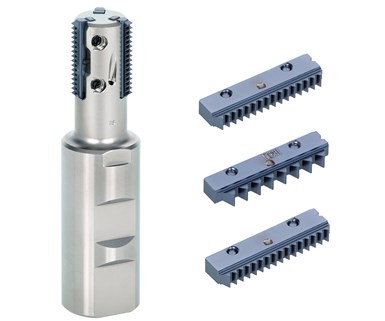Tungaloy's ETTL Insert Improves Efficiency for Parallel Thread Milling
Appears in Print as: ' Insert Improves Efficiency for Parallel Thread Milling'
Thread milling provides a high level of security thanks to the light cutting load generated when the tool breaks the chip in smaller pieces, preventing the chip from being jammed, which typically occurs during tapping.
Edited by

Tungaloy’s ThreadMilling ETTL indexable thread milling tool
The Tungaloy ETTL model for its ThreadMilling indexable thread milling tool series incorporates double-sided inserts with two cutting edges. The tool enables the production of various standard threads, such as ISO metric threads, Unified threads and Whitworth parallel pipe threads, on modern CNC milling machines and machining centers, using helical interpolation programs. Thread milling provides a high level of security thanks to the light cutting load generated when the tool breaks the chip in smaller pieces, preventing the chip from being jammed, which typically occurs during tapping.
ETTL tools are made in diameters ranging from 17 mm to 30 mm with flute counts of two, three and five. The insert clamping screws are embedded in the tool body so the screws will not come loose when exchanging the inserts. Tungaloy says the clamping force of the insert screws are enhanced over that of the existing ETLN style, improving feed rates and cutting performance. The tool is compatible with CNC programs that are being used for the existing style.
RELATED CONTENT
-
Tools and Technologies for Deep Hole Drilling
Understanding the challenges of deep hole drilling and knowing how to select and apply the appropriate tools will help a shop profit from this operation.
-
Bar Feeder Basics
Some primary factors are often overlooked when considering how to justify the implementation of a bar feeder for turning operations.
-
Advantages of Cellular Manufacturing
Manufacturing cells are used to minimize product movement as well as materials, equipment and labor during the manufacturing process. By reducing cycle times and material handling, these cells help shops more easily meet customer demands regarding cost, quality and leadtimes.


